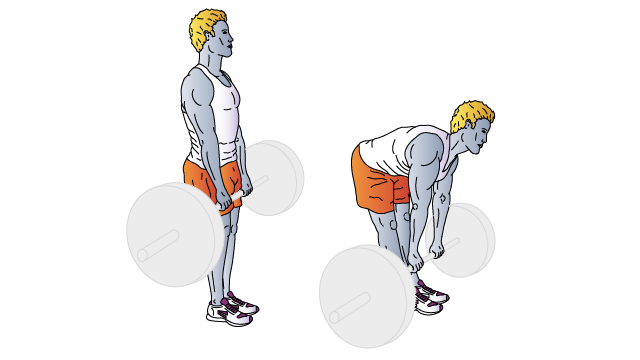DEADLIFT

The Deadlift is one of three powerlifting exercises; the others being Squat and Bench Press. It is actually considered by some to be a superior compound exercise to the Barbell Back Squat because it targets both the lower body and upper body as well as your core. As such it is an ideal total body exercise to build strength, mass, and stability.
Its movement pattern essentially involves lifting a weight off the ground to the hips and back down again. This is akin to a natural ‘functional’ movement pattern used in everyday life – namely picking something off the floor - and as such this exercise is ideal for developing functional fitness.
Unfortunately, the Deadlift has undeservedly earned a reputation for being a ‘dangerous lift’, especially for the lower back. Whilst it is true that this lift is less forgiving of poor form than some other lifts, this does not make it a dangerous lift per se. In fact, in terms of lifting mechanics, the Barbell Deadlift is an efficient lift, thereby making it comparatively safe, because it places the load directly over your body’s center of gravity. It only becomes dangerous if you can't center the barbell over your midfoot as a result of poor form, or the load is too heavy, but the same can be said for any lift. Most injuries occur because the lower back is allowed to flex, whereas correct Deadlift form dictates that your back should be kept in extension for the entire lift whilst keeping the bar over the middle of your feet. This is achieved by simultaneously engaging all of your core muscles (back muscles, abdominals, obliques, deep muscles of the pelvis) to stabilize the spine when lifting the bar.
The ‘dead’ in Deadlift refers to the act of lifting a stationary weight (i.e. one which is not assisted by momentum) from the floor, and is an example of only a few exercises where every rep begins with a dead weight.
Skill Level: Intermediate
Training: Strength
Type: Compound
Force: Pull
Equipment: Barbell
1° Muscles: Gluteals, Hamstrings, Lower Back, Erector Spinae
2° Muscles: Quadriceps, Mid & Upper Trapezius, Abdominals, Obliques, Latissimus Dorsi, Calves, Forearms
**IMPORTANT** Do not take this exercise lightly. If you suffer back issues, substitute this exercise with the dumbbell variant.
SET-UP
- Load a bar with an appropriate weight on the floor.
- Place your toes under the bar with your feet shoulder-width apart – your toes may point forward or slightly turned out and must be equidistant from the ends of the bar.
- Keeping your back straight and chest up, bend your knees and hips just enough to reach the bar - your hips should be kept higher than your knees, and keep your chin up whilst looking slightly down.
- With your arms straight and positioned outside your knees grasp the bar with a medium mixed grip (hands slightly wider than shoulder-width apart with one palm facing forward and the other facing you).
- Brace your core, and lean forward slightly so that your shoulders are directly over the bar.
EXECUTION
- Inhale.
- Exhale as you stand up by pushing through your heels keeping the bar as close to your body as possible as you straighten your legs.
- At the top of the lift, in the upright position push your hips forward and squeeze your gluteal muscles whilst simultaneously sticking your chest out and retract your shoulder blades.
- Inhale as you return the bar back to the start position by bending your knees and hips whilst simultaneously leaning your torso forward slightly.
- Ensure you maintain a neutral spine and keep the bar as close to your body as possible.
- To complete one rep allow the weight plates to touch the floor, and then immediately proceed to the next rep. Keep the movement smooth and continuous until all of the prescribed reps are complete.
- Repeat for the prescribed number of sets.
- If you are unable to get into the start position without rounding your back raise the barbell on blocks to a suitable start height to allow you to maintain a neutral spine.
- If you find it difficult to hold on to the bar with an overhand grip try an alternate grip (one hand with palm facing you, and the other facing away from you) or use wrist straps.
- Never round your back as this can cause back injury, focus on keeping your chest up and your back flat.
- Be cautious with the weight used; if in doubt, use less weight.
- Do not bounce the weight plates on the floor between reps; allow the bar to come to a dead stop after each rep.
- Keep your head in a neutral position, in line with the rest of your body; avoid overarching your neck by lifting your chin too much.
- Dumbbell Deadlift
- Sumo Deadlift
- Trap-Bar Deadlift
- Dumbbell Single-Leg Romanian Deadlift







